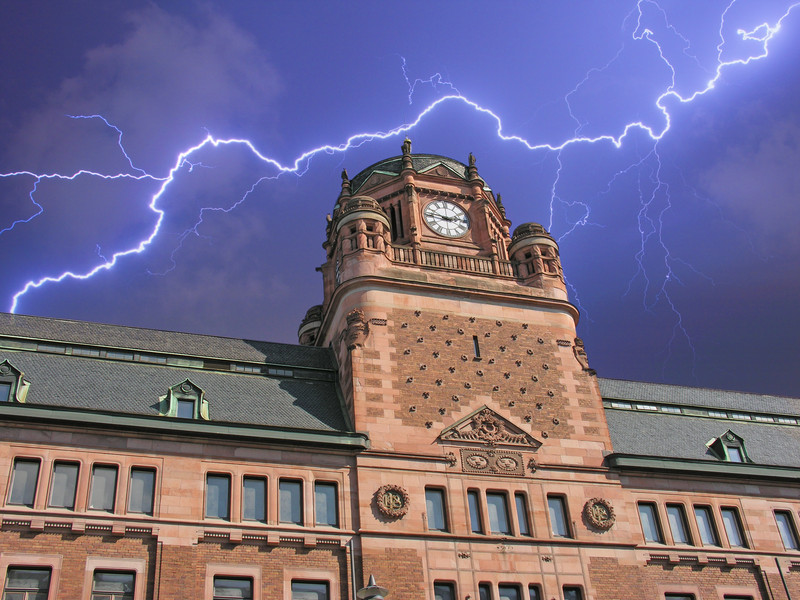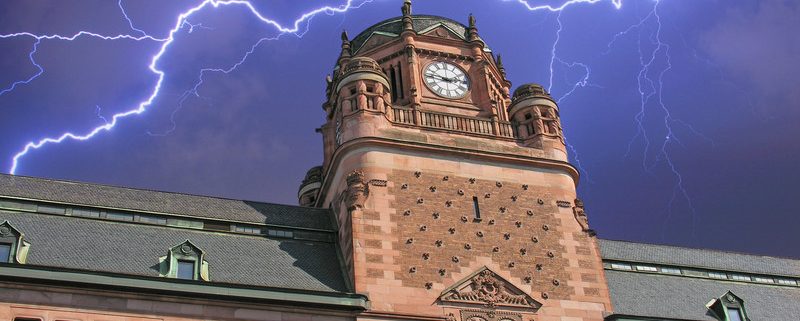Lightning Protection Systems
 Lightning Protection Systems
Lightning Protection Systems
Lightning protection systems are helpful for building and occupant safety. Each year, lightning is responsible for deaths, injuries, and costly property damage from direct hits and fires. Installing a lightning protection system in your next building project will provide an extra measure of safety against fire, damage, and harm to occupants should lightning strike.
What is the threat from lightning?
The threat from lightning is underrated – lightning strikes the US about 25 million times a year! A single bolt of lightning can deliver up to 100 million volts of electricity. Strikes can occur up to 10 miles away in all directions from a thunderstorm.
July is typically the deadliest month
for lightning strikes.
Lightning strikes are responsible for the loss of at least 50 lives in the US each year. Of those struck by lightning, 90% end up with varying degrees of disability. The Lightning Protection Institute (LPI) and National Weather Service promote lightning safety awareness with their personal safety campaign “When thunder roars, go indoors.”
According to Underwriters Laboratories, lightning strikes cause “an estimated $1 billion per year in structural damages in the United States alone.” This doesn’t account for the downtime, loss of business, and liability costs associated with lightning strikes. 23,000 fires are started in the US by lightning strikes. Most of this property damage could be prevented or minimized with the installation of lightning protection systems.
How do lightning protection systems work?
Lightning protection systems do not shield structures from lightning. Instead, they intercept and guide the lightning strike through a conductive path safely to the ground. Lightning protections systems are integrated into the building, providing a direct, low-resistance, low-impedance metallic path for current to follow from the roof to the ground. They are designed to prevent potential structural damage, fires, and harm to occupants.
In many areas, lightning protection systems for buildings are optional – each community determines which codes and standards should be followed.
A lightning protection system is composed of several components:
- Rods or air terminals protect your building from a direct strike. Lightning rods are placed at intervals at the high points of buildings. Lightning rods are unobtrusive, typically measuring 18” tall x ½” in diameter.
- Conductor cables carry the lightning current from the roof to the ground. The lightning rods are connected to a special copper wiring (a braided cable) that goes through the roof and interior of the building.
- Ground rods are buried in the ground and provide a safe path for the lightning away from the building. The conductor cables are attached to ground rods which carry the charge safely into the ground.
In this way, lightning is kept away from the electrical system, other building components, and building occupants. A complete system also includes surge protection for electrical systems and devices. According to the National Weather Service, a complete lightning system is needed to prevent surges and fires resulting from a lightning strike.
The National Fire Protection Association (NFPA) provides guidance and standards for lightning protection systems in the US. Since 1908, Underwriters Laboratories, Inc. (UL) has handled product testing of lightning protection material components. They also examine completed installations for compliance and have issued certificates for well-known structures such as the White House and Chicago’s Willis Tower. One of the leading lightning protection companies is Harger Lightning & Grounding, headquartered in nearby Grayslake.
Protect structures and building occupants
Due to the safety benefits gained from installing a lightning protection system, you’ll want to consider including one in your next building project. The new lightning protection system should meet the codes and standards of local building authorities and established by Underwriters Laboratories, the National Fire Protection Association, and the Lightning Protection Institute. In addition to the lightning protection system, further protection from lightning can be attained through bonding, grounding and surge protection, which will protect individuals in the building when using telephones, baths, kitchen sinks, and electrical appliances.



